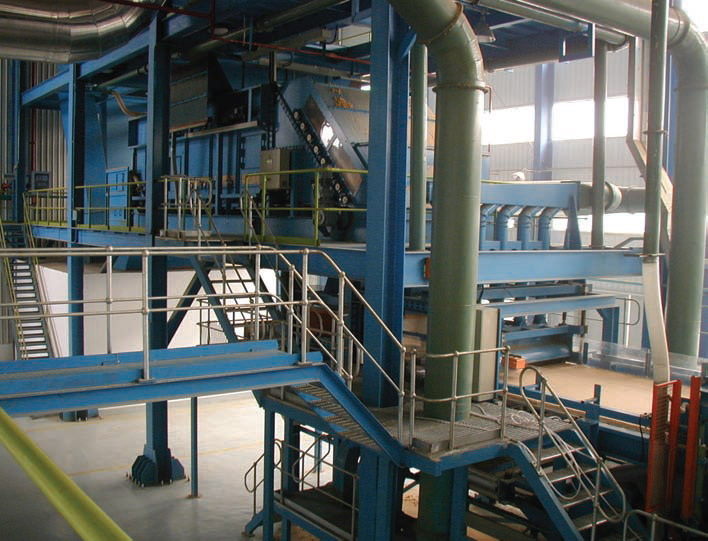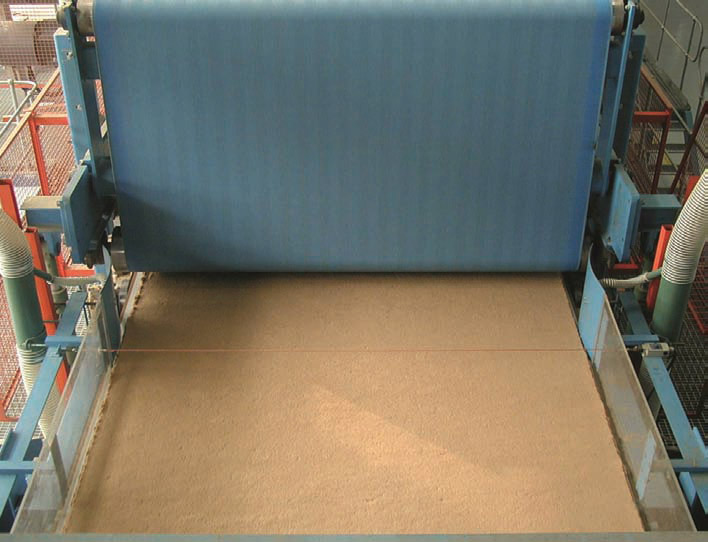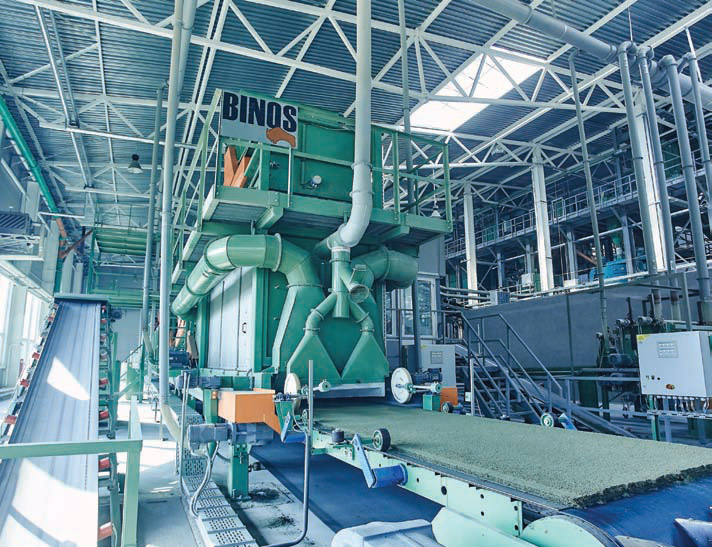Binos: Solutions whose time has come
6 December 2016Binos, long ahead of its time, has solutions that the market may now appreciate
Family connections, in case you had not noticed, are a theme of this focus on Germany. A few miles down the road from GreCon, at Springe, is the site of Binos; and the CEO of Binos is Tom Greten, grandson of the Ernst Greten whom we have just learned of at GreCon.
Binos used to be Bison, makers of presses and press lines, until hard times forced it to close in 1996; it reopened its premises in 1999 but by then the name had been taken by others. But they changed two letters around, and the animal is still out there in the forecourt of the premises, cast in metal, unmistakeably a bison; and the animal is leaner but otherwise unchanged.
The link with GreCon is, obviously, strong: "Basically, GreCon senses the material, makes the information visible; we touch the material and make sure that we touch it right," says Mr Greten.
The shared history is strong also. "It was our grandfather Ernst who invented the wind-forming machine for sorting fine and coarser particles for particleboard mats. He got the idea from agricultural winnowing machines which fanned the light stalks of chaff from heavy grains of corn."
Producing such machines was the start of Bison, back in 1952.
The company had a close relationship with Dieffenbacher. Many lines set up by Bison operated Dieffenbacher presses. There was also much research and development in the '70s and '80s on alternatives to wood as the raw material for panels. Date palm leaves were an example. "We explored to see if it works, tried to sell plants," says Mr Greten. They were ahead of their time; the market was generally not then interested. Wood was plentiful and cheap; why not use it?"
Times are very different now. Wood is not cheap; nor, in places like the Middle East is it plentiful, if it is locally available at all. Markets are now interested; and developing countries and markets are very interested indeed. A large dry date palm stalk and leaf lie propped in a corner of the Binos boardroom; samples of palm-leaf OSB are on the table. It is a concept whose time has now come.
"All these concepts have been under continuous care through the decades," says Mr Greten."The markets had not responded. But now, for example in the Emirates, there are no forests but a lot of demand for panels. So we are building a plant there for panels from date leaves." The approach, the expertise has been developed over many years. Significant deliveries began six months ago. "It is a pilot project for that size of plant," he says.
"Research was also being done in the '70s on other alternative biomass: straw, cotton waste, rice straw – any agricultural fibre in fact has the potential to be used as board. Whatever agrifibre a country, or a region, has in surplus which would otherwise go to waste can be made into board."
This is a company that likes alternatives and approaches that differ from the norm. It is true not only of alternative fibres. Binos is passionate for alternatives to resins as well. Mr Greten sings the praises of cement as the binder for fibre in panels – once again an old technology that Binos has been quietly developing and improving over the years.
"Unique to us is using gypsum or cement as binders, instead of petroleum-based resins. Cement-bonded panels again are 40 years old but are now modernised.
"You can think of the product as cement panels made lighter and stronger by having wood fibres inside, or as wood fibre panels with cement binder. Either way there is a big market development potential. Europe is ready for this kind of panel. It is ideal for external use. Its finish can look like brick, or like wood, or like anything you want. It keeps its looks brilliantly."
Mr Greten points through the window to the smart and handsome lift housing on the roof of the production unit opposite."That is made of cement panels, and it is 40 years old. Last year it had its first re-painting job in all that time." Binos calls it ‘The Particleboard for Eternity’.
And Mr Greten explains just why cement bonded board works so well.
"The wood inside is protected from moisture because the wood particles do not touch each other. The concrete surround stops the wood from swelling, the wood gives keeps the concrete flexibility against breaking." It seems ideal for the modular building methods – in the past called pre-fabricated – that must surely be a bigger part of future housing.
Why is it not more used? Once again, Binos has to wait for the markets to catch up.
"There is a vicious circle that we have to crack: architects look at what is available, the markets look at what architects use.
We have somehow to break into that circle, to educate the architects in this building material. We have a very good opportunity to build such plants in markets which have not developed yet. If we can trigger the markets we will be ready to deliver when requested. That’s where we are now!"
One trigger he suggests is simply to re-name the product. "Make the name fit the expectations of architects and potential users. Call it wood-reinforced cement panel, not cement-bonded particleboard. It contains 60% cement by weight, compared with 10% by weight of resins in particleboard. Or you could call it cement with agri-fibre reinforcement.
It can be cut with standard carpenters hand tools – hardened ones, but no-one uses the old unharded ones any more; so here again the market is catching up and a disadvantage of the past has disappeared.
It has good thermal properties ideal for prefabricated housing, and a green footprint: it is now possible to make it with agrifibre instead of wood. It is low energy to make – there is no hot press, no dryer – and it does not emit formaldehydes. So this is well prepared for the future. We see more and more applications for these products. They are most likely to be taken up first by poorer countries, but developed countries will latch on soon. We have helped set up plants for cement-board roughly once every three years; we are unique in that technology. It is the building material for the next generation of humans; and we are ready."
And, keeping the maverick approach and the appeal to smaller scale and less developed countries, Binos is an advocate of the Calender Press. This is neither daylight nor continuous belt but a large rotating drum against which a continuous steel belt presses, with the mat squeezed in between. Its advantages, says Mr Greten, include a high initial compression and a quick increase of temperature in the board, making it particularly suited to production of ultra-thin HDF from 0.5mm to 8mm thick. It gives, he says, economies on smaller scales and runs.
"We upscale as appropriate; we tailor make machines that are not available on the market. How to respond to local requirements, customisation – this is our core competence.
"At Binos we continuously follow market signals. We have such a wide bandwidth it is hard to say what is new. In some areas we trigger markets, in some areas we promote a 10-year-old solution to a problem that the market is just realising.
For example, there is the demand for flexibility – the ability to make two or three kinds of panels with several recipes: the market is just realising that need. Many particleboard plants are now starting to change over to MDF; OSB is a growing demand now, especially in Russia. We built many of the particleboard plants years ago, and now we are changing them over. And – another example – the date palm leaf plant can make OSB and particleboard on the same line."
Let us turn to some more main-stream solutions that Binos offers.
"Why is there a reason for Binos to exist? We claim to be best in one part of the pressing process: forming – or actually ultra-forming. Forming the best and most consistent high-quality mat is a particular speciality. It is more an approach than a specific machine. We no longer talk about 'single former machines' we talk about 'ultra-forming' to secure the best and most consistent and homogenous fibre mat for whatever the client wants to get out of the machine.
The UltraFormer, claims Binos, distributes the fibre particles in optimum densities, with larger particles in the centre of the mat, smaller and finer particles at the surface to give a smoother finish. "The BZ5 plant in Belarus – our latest plant for cement-bonded panels, completed in 2015 – can produce consistency and quality unseen up to now. How? Because we did so much more in regard to forming – ultra-forming again gives quality in cement-based particleboards as in all other types.
Pressing can be done in many ways. All rely on a good mat. How can a press resolve that if the mat is poor?
"Ultraforming is the driver through all the panel types - MDF, particleboard, cement-board and so on. We can prepare for maximising achievement in existing installations and in new factories.
"You could say that grandfather’s wind machine was the start of ultra-forming. So when it comes to the guarantees, together with GreCon we have the long-term understanding of it. That is why we feel strong, being able to secure leadership in that field for the future," says Mr GreCon.
"The company re-started in 1999, so now we are 17 years along the line. In the recession we reduced staff numbers, now we are ramping up again to reach the market in a better way with a good mix of the expertise of decades and new solutions to capitalise on that expertise.
"But we are still a small company, and small is flexible and beautiful. It lets us give weight to instinct, to feeling. When things need to be done we can move instantly, not wait six months for a board meeting decision. My philosophy is, when you are driving, look forward. Don’t look so much in the mirror!"


